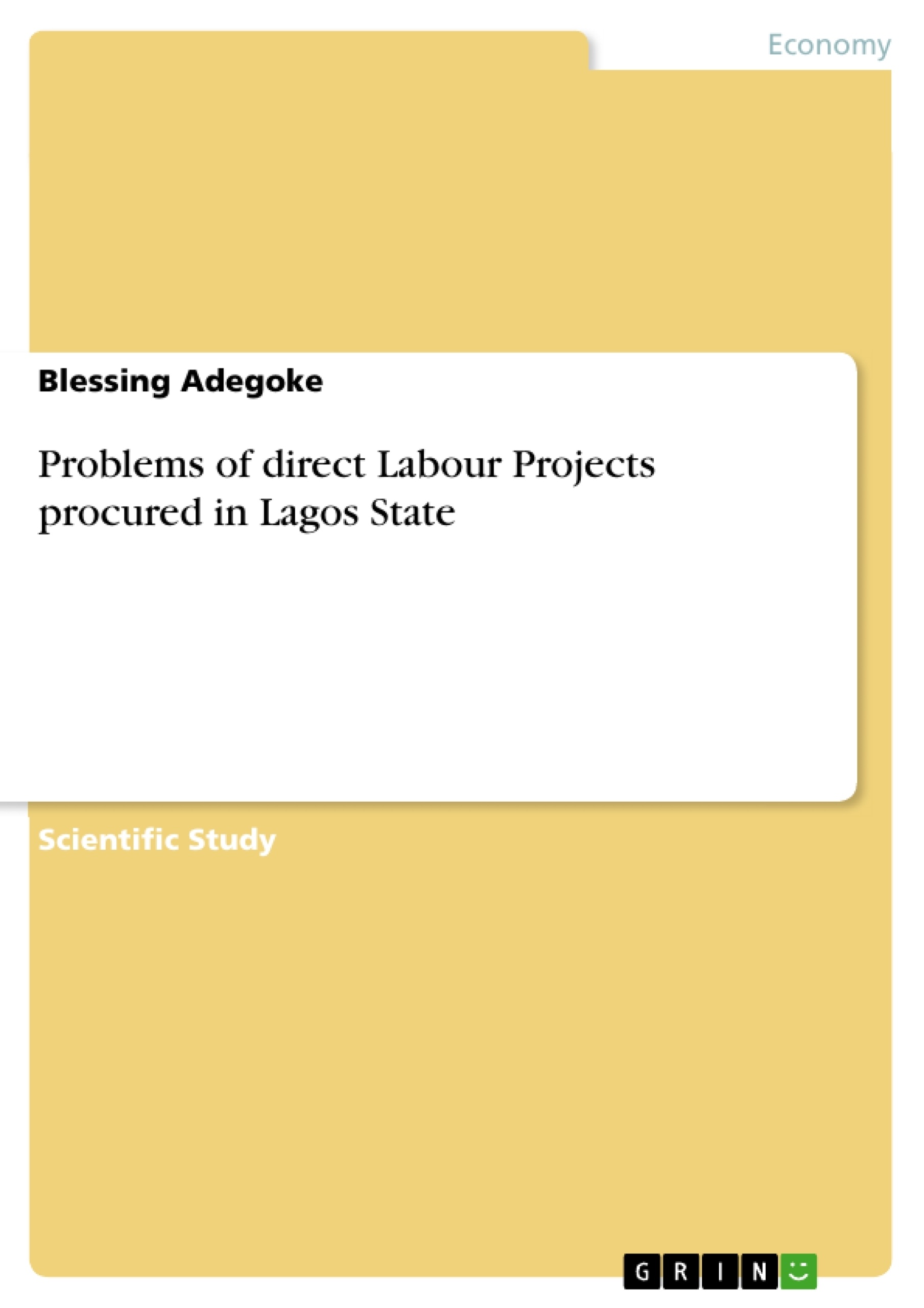Direct labour system is one of the several options of procurement used for project delivery process and records shows that it is the oldest procurement system and has been in use in Nigeria far back as the colonial era. It is very prominent in most countries and researchers described it as a system whereby a developer plans and organizes the project delivery process, carries out the design, the planning and procurement of resources and the construction of a project using client employed supervisory staff and labour. This type of system is regarded as in-house because client’s staffs as different from contractor’s staffs carry out the project delivery process and activities. Idoro, Iyagba and Odusami (2007) asserted that direct labour is mainly used for government projects. The use of the system is a good development in construction because it does not result in high staff strength and overhead costs in the Nigerian construction industry.
Inhaltsverzeichnis (Table of Contents)
- CHAPTER ONE
- 1.0 BACKGROUND OF STUDY
- 1.1 STATEMENT OF THE PROBLEM
- 1.2 AIMS AND OBJECTIVES OF THE STUDY
- 1.3 RESEARCH QUESTIONS
- 1.4 RESEARCH HYPOTHESIS
- 1.5 LIMITATION AND SCOPE OF THE STUDY
- 1.6 DEFINITION OF OPERATIONAL TERMS
- 1.7 SIGNIFICANCE OF THE STUDY
- CHAPTER TWO
- 2.1 INTRODUCTION
- 2.2 CONCEPTS OF DIRECT LABOUR SYSTEM
- 2.2.1 CHARACTERISTICS OF DIRECT LABOUR SYSTEM
- 2.2.2 ADVANTAGES OF DIRECT LABOUR SYSTEM
- 2.2.3 DISADVANTAGES OF DIRECT LABOUR SYSTEM
- 2.2.4 ROLES OF CLIENT IN DIRECT LABOUR PROJECT
- 2.3 CONCEPTS OF CONSTRUCTION PROCUREMENT SYSTEM
- 2.4 SELECTION CRITERIA OF PROCUREMENT SYSTEM
- 2.5 EFFECT OF PROCUREMENT SYSTEM ON CONSTRUCTION PERFORMANCE
- 2.6 PROBLEMS OF DIRECT LABOUR PROJECT
- 2.6.1 TIME OVERRUN
- 2.6.2 COST OVERRUN
- 2.6.3 QUALITY DEFECTS
- 2.6.4 FACTORS THAT CAUSES TIME AND COST OVERRUN
- 2.6.5 FACTORS THAT CAUSES QUALITY DEFECT
- 2.7 PROJECT PLANNING
- 2.7.1 PROJECT MONITORING
- 2.7.2 PROJECT EVALUATION
- 2.7.3 PROJECT COST CONTROL
- 2.8 PREVIOUS STUDIES
- CHAPTER THREE
- 3.1 INTRODUCTION
- 3.2 RESEARCH AREA
- 3.3 POPULATION OF THE STUDY
- 3.4 SAMPLE SIZE
- 3.5 SAMPLING TECHNIQUES
- 3.6 METHOD OF DATA COLLECTION
- 3.6.1 DEFINATION OF THE QUESTIONNAIRE
- 3.6.2 CONSTRAINT IN DATA COLLECTION
- 3.6.3 DATA ANALYSIS
- CHAPTER FOUR
- 4.1 INTRODUCTION
- 4.2 ANALYSIS AND PRESENTATION OF DESCRIPTIVE DATA
- 4.3 DATA PRESENTATION, ANALYSIS AND DISCUSSION OF FINDINGS IN RESPECT OF STATED OBJECTIVES
- 4.4 Summary
- CHAPTER FIVE
- 5.1 INTRODUCTION
- 5.2 CONCLUSION
- 5.3 RECOMMENDATION
Zielsetzung und Themenschwerpunkte (Objectives and Key Themes)
This study investigates the challenges associated with direct labor projects procured in Lagos State. The research aims to identify the primary factors contributing to time and cost overruns, as well as quality defects in these projects.- Evaluation of the direct labor system in construction project delivery
- Analysis of the impact of procurement systems on construction performance
- Identification of factors contributing to time and cost overruns in direct labor projects
- Examination of the relationship between procurement methods and quality defects
- Development of recommendations to improve the efficiency and effectiveness of direct labor projects in Lagos State
Zusammenfassung der Kapitel (Chapter Summaries)
Chapter One provides an overview of the research background, including the definition of the direct labor system and its significance in the Nigerian construction industry. It outlines the statement of the problem, aims and objectives, research questions, hypotheses, limitations, scope, operational terms, and the significance of the study. Chapter Two explores the concepts of direct labor systems, their characteristics, advantages, and disadvantages. It delves into the roles of clients in direct labor projects, construction procurement systems, and selection criteria. The chapter also examines the effect of procurement systems on construction performance and identifies specific problems associated with direct labor projects, such as time and cost overruns and quality defects. Chapter Three discusses the research methodology employed in the study, including the research area, population, sample size, sampling techniques, and methods of data collection and analysis. Chapter Four presents the analysis and discussion of the findings, focusing on the relationship between direct labor projects and the identified problems. It examines the data collected through questionnaires and interviews and presents the results in a descriptive and analytical manner.Schlüsselwörter (Keywords)
The study explores the challenges associated with direct labor projects procured in Lagos State. Key keywords include: direct labor system, procurement system, construction performance, time and cost overruns, quality defects, project planning, monitoring, and evaluation. The study also analyzes the influence of procurement methods on construction performance and the factors contributing to project inefficiencies.- Quote paper
- Blessing Adegoke (Author), 2010, Problems of direct Labour Projects procured in Lagos State, Munich, GRIN Verlag, https://www.grin.com/document/179103



